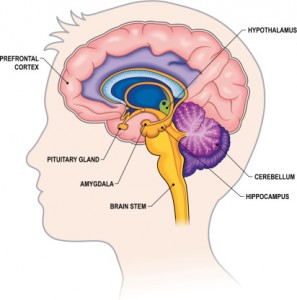Limbic System
The limbic system is a collection of brain structures that plays a role in unconscious bodily f unctions as well as emotion, learning, memory, and behavior. It is the part of the brain that feels and reacts, and although it is generally under control of the “thinking” part of the brain, it can react to stimuli on its own.
unctions as well as emotion, learning, memory, and behavior. It is the part of the brain that feels and reacts, and although it is generally under control of the “thinking” part of the brain, it can react to stimuli on its own.
Parts of the Limbic System
Included in the structures of the limbic system are the hypothalamus, one of the busiest areas of the brain, the hippocampus, which plays an important role in memory and spatial navigation, and the amygdala, which coordinates responses to stimuli and plays a part in emotion.
- Hypothalamus: The hypothalamus deals, for the most part, with homeostasis, or maintaining internal stability. It regulates hunger and thirst; responds to pain and pleasure; and controls anger, aggression, and sexual satisfaction. In addition, it is responsible for the function of the autonomic nervous system. This part of the brain instructs the body via both the autonomic nervous system and the pituitary gland.
- Hippocampus: A person’s memory depends on the hippocampus, a vital part of the brain that converts short-term memories to long-term memories. Damage to this part of the brain can prevent people from building new memories, though they can still remember events from the past. Though this situation seems somewhat fantastical, it is both real and serious: Often people who experience damage to the hippocampus cannot function without new memories and end up in institutions.
- Amygdala: The amygdala lies in feeling and discerning emotion, especially fear. It is most stimulated by events upon which a person’s survival depends, such as those that warn of danger or distress, as well as those that indicate necessary needs like food and water. Another important function of the amygdala is the combination of memory and emotion. This combination is seen most famously in Pavlov’s experiments in classical conditioning and fear conditioning, where the subject remembers and reacts to stimuli, be they positive, neutral, or negative.
Some other areas near the main structure of limbic system include:
- The cingulate gyrus, which deals with emotion and memory.
- The ventral tegmental area, made up of dopamine pathways that affect what pleasure a person may or may not feel.
- The prefrontal cortex, which also deals with pleasure, as well as one’s plans for the future.
- The basal ganglia, which controls repetitive behaviors.
History and Function
Scientific opinions on the role of the limbic system have shifted significantly in recent years. When the limbic system was first discovered, it was believed to be the emotional center of the brain. However, research showed that damage to this part of the brain also resulted in memory and cognitive impairments, indicating that it plays a significant role in other brain functions, as well. The limbic system as a whole is only loosely connected, and some scientists have argued that its individual parts should not necessarily be treated as part of the same system. Others point out that the way the parts work together enforce the fact that they are clearly a cohesive system.
Because the limbic system influences emotion and memory, it plays a strong role in behavior. Sexual arousal, for example, is due at least in part to functions in the limbic system. Degenerative conditions that affect the limbic system, including Alzheimer’s, can lead to radical changes in behavior. A significant effect of damage to the limbic system is the inability to recognize fear: when the amygdala is removed or destroyed, humans and animals no longer seem to recognize or react to stimuli that otherwise would have induced fear. People with damaged amygdalas have reported an inability to recognize fear in facial expressions, despite still being able to recognize all other expressions.
References:
- American Psychological Association. APA concise dictionary of psychology. Washington, DC: American Psychological Association, 2009. Print.
- Audesirk, T., Audesirk, G., & Byers, B. E. (2008). Biology: Life on earth with physiology. Upper Saddle River, NJ: Pearson Prentice Hall.
- Boeree, G. (2009, January 1). The Limbic System. Retrieved from http://webspace.ship.edu/cgboer/limbicsystem.html.
- Dubuc, B. (n.d.). The Amygdala and Its Allies. Retrieved from http://thebrain.mcgill.ca/flash/d/d_04/d_04_cr/d_04_cr_peu/d_04_cr_peu.html.
- Wright, A. (n.d.). Limbic System: Amygdala. Retrieved from http://neuroscience.uth.tmc.edu/s4/chapter06.html.
Last Updated: 08-11-2015
- 3 comments
- Leave a Comment
-
Montgomery
March 31st, 2021 at 6:41 AMVery informative!
-
Ghazwan
February 26th, 2022 at 5:25 PMsince 10 years ago the feelings ( love , hate , sad , enjoying , anger , hunger
, laugh , smile and all feelings positive and negative i don’t feel by any of those
began decreases ,and today i don’t feel by any feel of those i become
like robot , only eat and drink and suffer every thing
l think a part of my brain is died ( limbic brain ), please can you help me -
Rachel
January 23rd, 2023 at 8:12 AMIf part of this system is damaged, how can you treat it?
Leave a Comment
By commenting you acknowledge acceptance of GoodTherapy.org's Terms and Conditions of Use.
